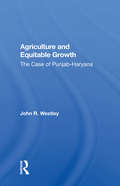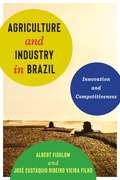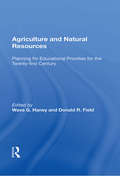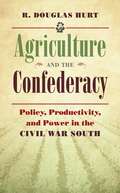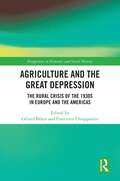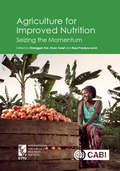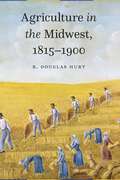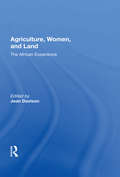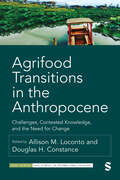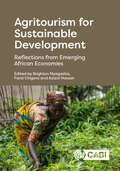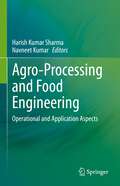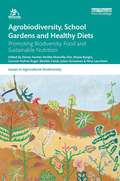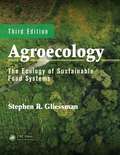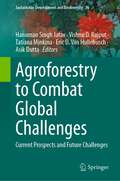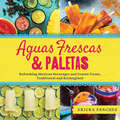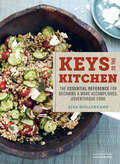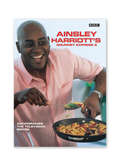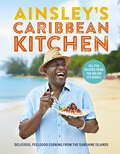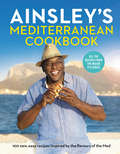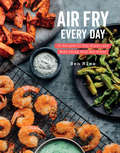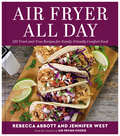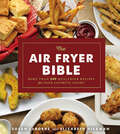- Table View
- List View
Agriculture And Equitable Growth: The Case Of Punjab-haryana
by John R. WestleyThis book aims to examine how the pattern of growth in the agricultural sectors has contributed to equitable growth and to assess the relevance of the relationship between agriculture and equitable growth in Punjab-Haryana for other states in India and for other low-income countries.
Agriculture and Industry in Brazil: Innovation and Competitiveness
by José Eustáquio Vieira Filho Albert FishlowAgriculture and Industry in Brazil is a study of the economics of Brazilian agriculture and industry, with a special focus on the importance of innovation to productivity growth. Albert Fishlow and José Eustáquio Ribeiro Vieira Filho examine technological change in Brazil, highlighting the role of public policy in building institutions and creating an innovation-oriented environment.Fishlow and Vieira Filho tackle the theme of innovation from various angles. They contrast the relationship between state involvement and the private sector in key parts of the Brazilian economy and compare agricultural expansion with growth in the oil and aviation sectors. Fishlow and Vieira Filho argue that modern agriculture is a knowledge-intensive industry and its success in Brazil stems from public institution building. They demonstrate how research has played a key role in productivity growth, showing how prudent innovation policies can leverage knowledge not only within a particular company but also across whole sectors of the economy. The book discusses whether and how Brazil can serve as a model for other middle-income countries eager to achieve higher growth and a more egalitarian distribution of income. An important contribution to comparative, international, and development economics, Agriculture and Industry in Brazil shows how the public success in agriculture became a prototype for advance elsewhere.
Agriculture And Natural Resources: Planning For Educational Priorities For The Twenty-first Century
by Donald R. Field Wava G. HaneyThis book identifies issues and trends in agriculture, natural resources, and rural communities in the context of topical strategic planning. It portrays both the process of planning and the substantive content driving a planning process. .
Agriculture and the Confederacy
by R. Douglas HurtIn this comprehensive history, R. Douglas Hurt traces the decline and fall of agriculture in the Confederate States of America. The backbone of the southern economy, agriculture was a source of power that southerners believed would ensure their independence. But, season by season and year by year, Hurt convincingly shows how the disintegration of southern agriculture led to the decline of the Confederacy's military, economic, and political power. He examines regional variations in the Eastern and Western Confederacy, linking the fates of individual crops and different modes of farming and planting to the wider story. After a dismal harvest in late 1864, southerners--faced with hunger and privation throughout the region--ransacked farms in the Shenandoah Valley and pillaged plantations in the Carolinas and the Mississippi Delta, they finally realized that their agricultural power, and their government itself, had failed. Hurt shows how this ultimate lost harvest had repercussions that lasted well beyond the end of the Civil War.Assessing agriculture in its economic, political, social, and environmental contexts, Hurt sheds new light on the fate of the Confederacy from the optimism of secession to the reality of collapse.
Agriculture and the Great Depression: The Rural Crisis of the 1930s in Europe and the Americas (Perspectives in Economic and Social History)
by Gérard Béaur Francesco ChiapparinoWhat role did the agricultural sector play in the economic crash of 1929? Taking evidence from country cases across Europe and the Americas, this edited volume explores short-, medium- and long-term perspectives on the primary sector. The monograph brings together the voices of an international panel of contributors who examine issues such as falling prices, industrial production, unemployment and the stagnation of aggregate demand. Together, they frame the interwar period as a pivotal turning point in the decline of subsistence agriculture and the growth of agricultural subsidies, which remain a key policy tool in many economies today. This illuminating book will be of interest to advanced students and researchers in economic history, agricultural history, globalization, and economic development.
Agriculture for Improved Nutrition: Seizing the Momentum
by Noora-Lisa Aberman Mathew Abraham Akhter U. Ahmed Summer Allen Suresh Chandra Babu Ekin Birol Anne Bossuyt Howarth E. Bouis Kevin Chen Gerald F. Jr Olivier Ecker Dr Jessica Fanzo Aulo Gelli Julie Ghostlaw Stuart Gillespie Daniel O. Gilligan Lawrence Haddad Derek Headey Mar Maestre Hazel Malapit William Masters Ruthie Musker Nicholas Nisbett Rajul Pandya-Lorch Prabhu L Pingali Daniel J. Raiten Marie T. Ruel Amy Saltzman Zimeiyi Wang Sivan YosefAgriculture's vast potential to improve nutrition is just beginning to be tapped. New ideas, research, and initiatives developed over the past decade have created an opportunity for reimagining and redesigning agricultural and food systems for the benefit of nutrition. To support this transformation, this book reviews the latest findings, results from on-the-ground programs and interventions, and recent policy experiences from countries around the world that are bringing the agriculture and nutrition sectors closer together. Drawing on IFPRI's own work and that of the growing agriculture-nutrition community, this book strengthens the evidence base for, and expands our vision of, how agriculture can contribute to nutrition. Chapters cover an array of issues that link agriculture and nutrition, including food value chains, nutrition-sensitive programs and policies, government policies, and private sector investments. By highlighting both achievements and setbacks, Agriculture for Improved Nutrition seeks to inspire those who want to scale up successes that can transform food systems and improve the nutrition of billions of people. Key features: -Investigates the latest evidence on the relationship between agriculture and nutrition. -Includes insights from internationally renowned researchers. -Presents data from real-world settings that is highly relevant to the challenges faced by developing countries. This book is ideal for policy-makers, practitioners, and students working in agriculture, international development and nutrition.
Agriculture in the Midwest, 1815–1900
by Prof. R. Douglas HurtAfter the War of 1812 and the removal of the region&’s Indigenous peoples, the American Midwest became a paradoxical land for settlers. Even as many settlers found that the region provided the bountiful life of their dreams, others found disappointment, even failure—and still others suffered social and racial prejudice. In this broad and authoritative survey of midwestern agriculture from the War of 1812 to the turn of the twentieth century, R. Douglas Hurt contends that this region proved to be the country&’s garden spot and the nation&’s heart of agricultural production. During these eighty-five years the region transformed from a sparsely settled area to the home of large industrial and commercial cities, including Chicago, Milwaukee, Cleveland, and Detroit. Still, it remained primarily an agricultural region that promised a better life for many of the people who acquired land, raised crops and livestock, provided for their families, adopted new technologies, and sought political reform to benefit their economic interests. Focusing on the history of midwestern agriculture during wartime, utopian isolation, and colonization as well as political unrest, Hurt contextualizes myriad facets of the region&’s past to show how agricultural life developed for midwestern farmers—and to reflect on what that meant for the region and nation.
Agriculture, Women, And Land: The African Experience
by Jean DavisonThis book examines gender relations to land relations that are crucial to formulating policies through which African women's food producing capabilities can be advanced. It addresses the need to document historical changes in land tenure practices that have influenced women's household production.
Agrifood Transitions in the Anthropocene: Challenges, Contested Knowledge, and the Need for Change (SAGE Studies in International Sociology)
by Allison M. Loconto Douglas H. ConstanceThe greatest challenges of the twenty-first century stem from the fact that we are now living in a new epoch: the Anthropocene. The human footprint on the planet can no longer be denied. One of the greatest and most essential human innovations, agriculture, is being increasingly recognised as a leading contributor to climate change. According to global governance bodies, the world will need to feed a predicted nine billion people by 2050. However, in this Anthropocene, we must address the environmental inequalities in how these people will be fed. This book explores our current societal struggles to transition towards more sustainable agrifood systems. It suggests that debates around sustainable agriculture must be social as well as technical, exploring the growth of social movements campaigning for more democratic food systems. However, as each chapter demonstrates, both the problems and the solutions in sustainable agriculture are highly contested. Using the term ′agrifood′ to capture the nexus between research, governance and the environment knowledge-environment-governance, this book provides an in-depth and wide-ranging account of current research around agricultural production and food consumption. The book introduces the Anthropocene along with the fundamental question that it poses about human-nature interactions. It outlines the core concerns related to agriculture and food and the debates around the need for agrifood system transitions. Each chapter investigates controversies in the field through case studies. These contributions offer a call for sociologists of agriculture and food to engage with the controversies unfolding in the Anthropocene.
Agrifood Transitions in the Anthropocene: Challenges, Contested Knowledge, and the Need for Change (SAGE Studies in International Sociology)
by Allison M. Loconto Douglas H. ConstanceThe greatest challenges of the twenty-first century stem from the fact that we are now living in a new epoch: the Anthropocene. The human footprint on the planet can no longer be denied. One of the greatest and most essential human innovations, agriculture, is being increasingly recognised as a leading contributor to climate change. According to global governance bodies, the world will need to feed a predicted nine billion people by 2050. However, in this Anthropocene, we must address the environmental inequalities in how these people will be fed. This book explores our current societal struggles to transition towards more sustainable agrifood systems. It suggests that debates around sustainable agriculture must be social as well as technical, exploring the growth of social movements campaigning for more democratic food systems. However, as each chapter demonstrates, both the problems and the solutions in sustainable agriculture are highly contested. Using the term ′agrifood′ to capture the nexus between research, governance and the environment knowledge-environment-governance, this book provides an in-depth and wide-ranging account of current research around agricultural production and food consumption. The book introduces the Anthropocene along with the fundamental question that it poses about human-nature interactions. It outlines the core concerns related to agriculture and food and the debates around the need for agrifood system transitions. Each chapter investigates controversies in the field through case studies. These contributions offer a call for sociologists of agriculture and food to engage with the controversies unfolding in the Anthropocene.
Agritourism for Sustainable Development: Reflections from Emerging African Economies
by Admire Mthombeni Bronson Mutanda Collen Sabao Dumisani Rumbidzai Muzira Dzingai Kennedy Nyahunzvi Edward Chinongwa Enard Mutenheri Ernest Mugoni Felix Chari Geoffrey Korir Gilda Eyang Gracious Mutipforo Hellen Amunga Jabulani Garwi Judith Moyo Katsande Chipo Martin Dzapasi Noreen Watyoka Nyasha Tendai Makiwa Lucyna Przezborska-Skobiej Komborerai Wilfred Chikwape Obert Sifile Ranganayi Njodzi Raymond Mapuranga Regis Muchowe Samulo Mutale Sharon Chisango Shingirai Siziba Solomon Marime Tendai Shelton Muwani Tichakunda Valentine Chabata Willard Muntanga Yeukayi Dzapasi Zibanai ZhouThrough the lens of African emerging economies, this text examines empirical studies and the related practices of agritourism. By looking at tourism innovation, entrepreneurship ethics and responsibility of public and private organizational stakeholders, the text promotes an understanding of how radical novel sustainable agritourism might be implemented to help society's living become more sustainable with low usage of material resources, low energy and environmental cost. Informed by the 2030 Agenda for Sustainable Development and Sustainable Development Goals (SDGs) framework, which emphasize the fostering of novel sustainable agritourism, the book includes: methodologies, theory, reviews, primary research findings and practice topics such as start-ups, legal aspects, CSR and digital technologies techniques and tools with global application The book will be of interest to academics and postgraduate students interested in the challenges of sustainable agritourism and African emerging economies.
Agro-Processing and Food Engineering: Operational and Application Aspects
by Harish Kumar Sharma Navneet KumarThis textbook highlights the engineering fundamentals and processing aspects of agricultural produce and covers important aspects of agro-processing and food engineering in one place. The chapters cover material handling, drying, size reduction process, mixing and forming, cleaning and separation, storage, and processing of cereals, pulses, oilseeds, fruit and vegetables, and their products. The book’s contents are systematically designed to provide a balanced overview of agro-processing techniques from the basic concepts to the case study, handling of the materials, and different unit operations. The systematic and simple elaboration of scientific aspects will make it unique and help to develop skills in the field. Many illustrations in form of diagrams/charts/pictures provide a clear understanding. Solved numerical problems, which are given in the chapters, will provide students clarity in conceptualizing the basics. The book covers the syllabus related to agro-processing and food engineering at the undergraduate and postgraduate level in various universities, agricultural universities, allied institutes, and colleges across the globe. It will be extremely beneficial to students as it covers the most important and relevant topics, which are hardly covered in any other single compilation and published textbooks. It would be a good textbook for universities, agricultural universities, institutes, and colleges running courses in agriculture, horticulture, postharvest technology, process and food engineering, food engineering, food engineering and technology, food technology, food science, and food and nutrition.
Agrobiodiversity, School Gardens and Healthy Diets: Promoting Biodiversity, Food and Sustainable Nutrition (Issues in Agricultural Biodiversity)
by Danny HunterThis book critically assesses the role of agrobiodiversity in school gardens and its contribution to diversifying diets, promoting healthy eating habits and improving nutrition among schoolchildren as well as other benefits relating to climate change adaptation, ecoliteracy and greening school spaces. Many schoolchildren suffer from various forms of malnutrition and it is important to address their nutritional status given the effects it has on their health, cognition, and subsequently their educational achievement. Schools are recognized as excellent platforms for promoting lifelong healthy eating and improving long-term, sustainable nutrition security required for optimum educational outcomes. This book reveals the multiple benefits of school gardens for improving nutrition and education for children and their families. It examines issues such as school feeding, community food production, school gardening, nutritional education and the promotion of agrobiodiversity, and draws on international case studies, from both developed and developing nations, to provide a comprehensive global assessment. This book will be essential reading for those interested in promoting agrobiodiversity, sustainable nutrition and healthy eating habits in schools and public institutions more generally. It identifies recurring and emerging issues, establishes best practices, identifies key criteria for success and advises on strategies for scaling up and scaling out elements to improve the uptake of school gardens.
Agroecology: The Ecology of Sustainable Food Systems
by Stephen GliessmanAgroecology is a science, a productive practice, and part of a social movement that is at the forefront of transforming food systems to sustainability. Building upon the ecological foundation of the agroecosystem, Agroecology: The Ecology of Sustainable Food Systems, Third Edition provides the essential foundation for understanding sustainability in all of its components: agricultural, ecological, economic, social, cultural, and even political. It presents a case for food system change and why the current industrial model of food production and distribution is not sustainable.
Agroforestry to Combat Global Challenges: Current Prospects and Future Challenges (Sustainable Development and Biodiversity #36)
by Hanuman Singh Jatav Vishnu D. Rajput Tatiana Minkina Eric D. Van Hullebusch Asik DuttaThis edited book brings out comprehensive insights on agro-forestry systems to cope up climate change globally. The main essence of this book is to unfurl the positive sides of agri-silvipastoral system to reduce greenhouse gases (GHGs) and temperature. Agro-forestry can be defined as the farming practice combining field crops, perennial trees and livestock. The impact of agro-forestry on ecology is implacable which is thoroughly discussed under different heads in this book. In addition, the book is bundle of different novel sections including tables, graphical representation, and figures showcasing the bright side of agro-forestry system. Furthermore, trees which are important component of boosting socio-economic conditions, especially for the indigenous populations have also been discussed meticulously. Hence, all together this book deciphers an account of agro-forestry practices in society and environment along with the major pros- and cons- of the system. Undoubtedly, this information could enrich the scholarly knowledge for graduate research fellows, teachers, scientists, researchers, and environmentalists in gaining multifaceted information of agro-forestry system in both ecological and economical aspects. Different research highlights will be helpful for the policy makers to implement this novel practice in intensive production systems and harness the maximum benefits out of this.
Aguas Frescas & Paletas: Refreshing Mexican Drinks and Frozen Treats, Traditional and Reimagined
by Ericka SanchezAguas frescas (fresh waters) and paletas are the perfect summer treat sure to satisfy the whole family!
Aida Mollenkamp's Keys to the Kitchen: The Essential Reference for Becoming a More Accomplished, Adventurous Cook
by Alex Farnum Aida MollenkampFood Network and Cooking Channel star Aida Mollenkamp lays an invaluable foundation for cooks in How to Be in the Kitchen. This comprehensive manual collects more than 300 innovative, contemporary recipes as well as color photographs, plenty of informative illustrations, a substantial technique primer, and helpful how-to information on subjects as wide-ranging as rust removal, throwing a cocktail party, and knife skills. For members of the tech-savvy new generation who can't cook but want to, this essential reference guide makes an ideal starting place and for those already at ease in the kitchen it's full of "who knew" moments for expanding their repertoire of great recipes.
Ainsley Harriott's Friends & Family Cookbook
by Ainsley HarriottAinsley Harriott is a best-selling BBC author and has sold over a million copies of his books to date. As fans of his Meals in Minutes titles already know, Ainsley is the chef who really understands the sort of food most of us want to make at home. Now he's back with his Friends and Family Cookbook, the ultimate reference book to reflect the way we cook and eat today. The book covers everything from planning what to eat for the week ahead and shopping, to timing a Sunday lunch and organising a supper party. Ainsley's Friends and Family Cookbook also contains step-by-step sequences to make particular techniques even more straightforward, lots of alternatives for everyday recipes like pizza and pasta and plenty of low-fat dishes if you are watching what you eat. The book contains over 230 brand new delicious recipes all using readily available ingredients, and with each one illustrated to encourage you to have a go, it is an essential addition to any kitchen shelf.
Ainsley Harriott's Gourmet Express 2
by Ainsley HarriottFollowing on from the success of the first Gourmet Express book, Ainsley is back with a new collection of simple and sensational dishes that are designed for those who love good food, but dont have time to follow long and complicated recipes. Whether you need fresh ideas for family meals, or are having friends round for an informal supper, there are recipes here to suit every occasion. For a quick and delicious weekend brunch how about trying Ainsleys Pancetta Hash Browns? Or get the morning off to a healthy start with a Pineapple and Coconut Smoothie. Starters include Crispy Noodle-wrapped Prawns with Rice-wine Dipping Sauce and the delicious Hot Bloody Mary Soup. For the main course, Ainsley has a whole host of suggestions from Fresh Charred Tuna Steak with Salsa Verde, to the warming Clares Winter-vegetable Cobbler. And for the perfect end to a fabulous menu, Ainsleys ideas include scrumptious desserts such as Six-minute Soft-centred Chocolate Puddings and Cranberry and Pomegranate Jellies. Complete with over 40 stunning full-colour photographs, Gourmet Express 2 is guaranteed to show that you too can produce fabulous food without spending hours in the kitchen.
Ainsley's Caribbean Kitchen: Delicious feelgood cooking from the sunshine islands. All the recipes from the major ITV series
by Ainsley Harriott"I can't recommend this book highly enough. Never pretentious, always fun, it reflects Ainsley Harriott's persona wonderfully." The Telegraph on SaturdayThe stunning official tie-in to Ainsley’s major ITV1 show includes all the recipes from the series. Join the nation’s favourite TV cook on his food adventure. Ainsley Harriott is going back to his roots to uncover the best-kept secrets and simple dishes of Caribbean home cooking in this ultimate feel-good cookbook. Among the brand-new, mouthwatering recipes that are featured on the show, there will be over 80 dishes inspired by the diverse culture and the rich food heritage of these much-loved islands. You’ll find light dishes and snacks such as Crab and chilli cornbread muffins and Chickpea and plantain patties; flavoursome main meals including Grilled chicken roti wrap with mango dressing and Grilled lamb cutlets with green herb yoghurt; not forgetting indulgent desserts and cocktails including White chocolate, rum and raspberry crème brulee and Lazy man’s long island iced tea. This stunning cookbook will bring exciting new meals to your family table and transport you to the real Caribbean in your own kitchen.
Ainsley’s Good Mood Food: Easy, comforting meals to lift your spirits
by Ainsley HarriottWarm your cockles and lift your spirits ...Including the recipes from series 1 of Ainsley's ITV show, plus many more dishes to make you happy!Because there's no two ways about it - food can definitely raise your spirits. In this uplifting cookbook you will find comforting classics, great food for sharing, recipes for a bit of indulgence, light and healthy dishes to help you feel good from the inside out, easy one-pots that are all weeknight winners, some favourite barbecue dishes to bring sunshine to your table, and delicious desserts because - because we all need a treat now and again.Happy Cooking!
Ainsley’s Mediterranean Cookbook
by Ainsley HarriottTravel the Med without leaving your kitchen.Join national treasure Ainsley Harriott on his culinary journey through the Mediterranean discovering the very best recipes to cook back home. Ainsley’s Mediterranean Cookbook includes all the recipes from his major 10-part ITV1 series. Journeying through Spain, Sardinia, Morocco, Corsica and Jordan, Ainsley shows how easy and enjoyable it can be to make fresh, healthy, delicious meals.From simple salads and dips to everyday favourites like pasta and risottos, satisfying meats, flavoursome vegetarian mains and light fish dishes, Ainsleys’s recipes are perfect for a relaxed gathering of family and friends or hassle-free midweek meal. Recipes include: Corsican mint omeletteMoroccan vegetable and sesame seed parcelsCourgette, lemon and pecorino spaghettiButternut squash and sweet potato tagineNutty pearl couscous with feta and datesAromatic fish pilafPasta shells with sausage, tomato and fennel sauceHazelnut and chocolate cakeOrange and cinnamon hot chocolate
Air Fry Every Day: 75 Recipes to Fry, Roast, and Bake Using Your Air Fryer
by Ben MimsThe go-to cookbook for your new favorite kitchen gadget--with better-for-you recipes for your favorite indulgencesThe air fryer is the newest must-have kitchen appliance, and it's easy to see why: favorite fried foods come out perfectly crispy and crunchy, using little to no oil, and have a fraction of the calories that their traditionally fried counterparts have. The high-powered convection heating translates to faster cook times, and with so little oil, you'll have easy clean-up too. Air Fry Every Day shows you how to use your air fryer to create healthier fresh takes on comfort food classics, crowd-pleasing snacks, and kid-friendly dishes, such as buffalo wings, coconut shrimp, shoestring fries, stuffed blooming onions with lemon aioli, and spiced sweet potato wedges with garlic yogurt dip. You'll also find deliciously unexpected ways to put your air fryer to use in recipes such as golden bread crumb-crusted cider-brined pork chops, crispy air-fried rice, and beautifully bronzed whole heads of cauliflower. An air fryer is also incredibly versatile: with its powerful convection heating, it can bake, roast, and steam at superfast speeds, so in addition to craveworthy "fried" foods, you'll find recipes for roasted meats, breads, pizzas, and even desserts and sweet baked goods--you may never turn your oven on again. With recipes that are creative, fast, and foolproof, and essential tips and techniques to maximize your air fryer's capabilities, Air Fry Every Day is the best reason why you should add this tool to your arsenal of kitchen gadgets.
Air Fryer All Day: 120 Tried-and-True Recipes for Family-Friendly Comfort Food
by Rebecca L. Abbott Jennifer WestFrom the creators of the mega-popular blog Air Frying Foodie, 120 easy, delicious, and crowd-pleasing air fryer recipes.The air fryer has become an essential appliance, gracing counters in a majority of kitchens in the United States. As more home cooks have come to depend on this amazing gadget, they’ve needed to turn to trusted sources and online communities for tips, tricks, and simple, dependable recipes. Their number-one destination? Jennifer West and Rebecca Abbott’s hugely popular website, Air Frying Foodie, in addition to their Facebook group, Easy Air Fryer Recipes.What their millions of loyal followers know is that they can depend on Jen and Becky’s expertise as well as their creativity. Because as the go-to air fryer authorities, they understand that the air fryer isn’t just for party foods anymore—it’s for getting quick, healthy, inexpensive, complete meals on the table. In Air Fryer All Day, Jen and Becky take their recipes from the web to the page for the first time, sharing 120 family-friendly air fryer meals for breakfast, lunch, and dinner—plus dessert—often in less time than it takes to preheat your oven and with minimal cleanup. These include foolproof, feel-good dishes like:Spinach and Feta Egg BitesEnchilada Quinoa CasseroleChicken Parm BitesCountry-Style RibsVegetable Pot PieBacon-Wrapped ShrimpBrownie Baked AlaskaWhether you’ve been an air fryer devotee for years, or are just getting started, Air Fryer All Day is the only cookbook you'll need.
The Air Fryer Bible: More Than 200 Healthier Recipes for Your Favorite Foods
by Susan LaBorde Elizabeth HickmanA comprehensive cookbook for using an air fryer to create lower-fat, healthier versions of all your favorite homecooked meals. Harnessing the power of circulating hot air, air fryers cook all your beloved comfort foods to crunchy, tasty perfection . . . without all the messy oil. The Air Fryer Bible cookbook shows you how to make the most of this hugely popular appliance to create more than 200 amazing dishes: Start your day with Quiche Cups or French Toast Sticks. Snack on Mozzarella Sticks and String Bean Fries. Feast on Coconut Chicken with Apricot-Ginger Sauce or Fish Tacos with Jalapeño-Lime Sauce, and then indulge yourself with Apple Crisp or Brownies After Dark. These recipes will save you time, promote heart health, and can even help with weight loss. They’re easy enough for a beginner, and your whole family will love them.Complete with numerous tips for air fryer success, thirty mouthwatering photos of finished dishes, must-have appliance-buying information, and a comprehensive index, The Air Fryer Bible is the only air fryer cookbook you’ll ever need.
